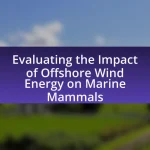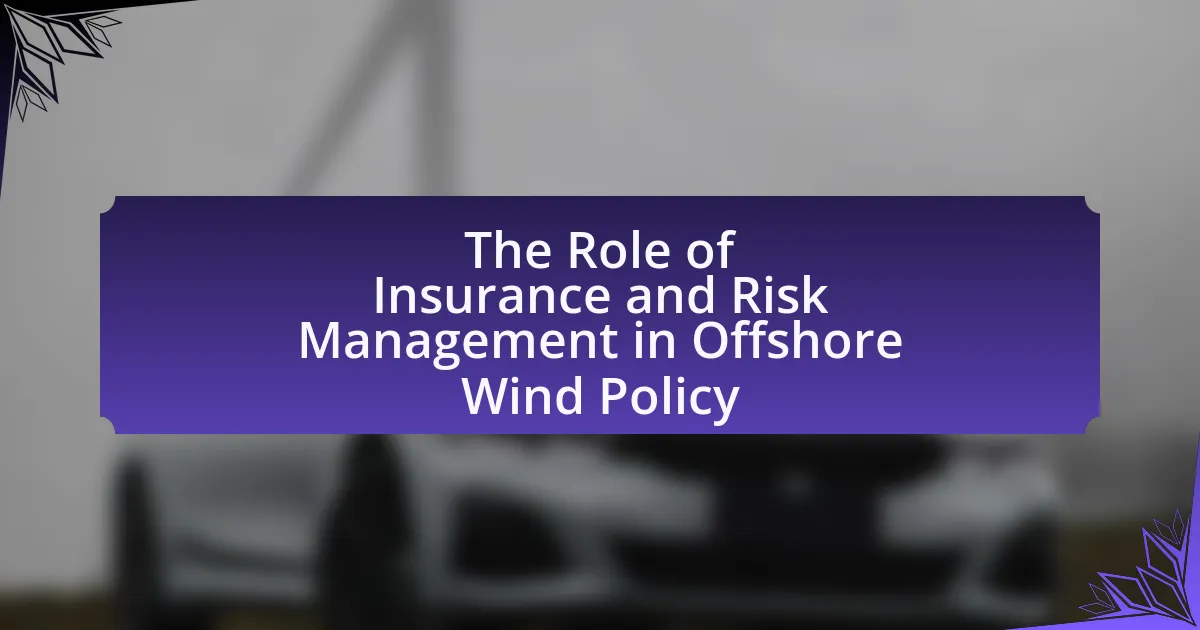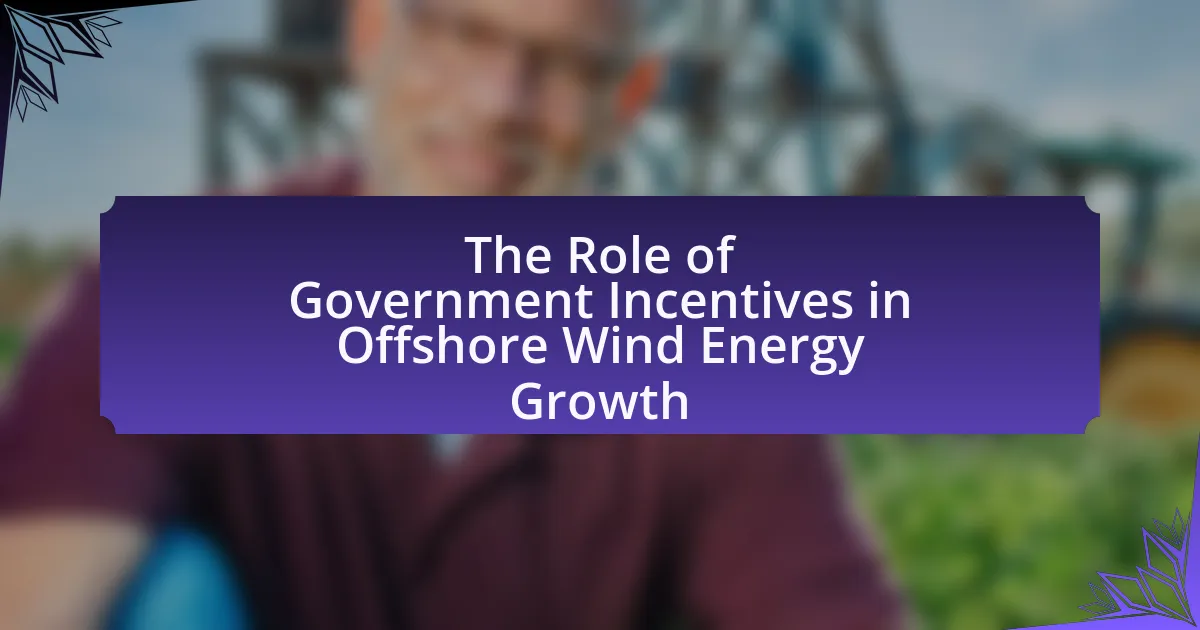The article focuses on the future trends in offshore wind energy legislation, highlighting the increasing government commitments to renewable energy, streamlined permitting processes, and enhanced environmental regulations. It discusses how governments are adapting policies to promote offshore wind energy through investment incentives and ambitious capacity targets, such as the European Union’s goal of 300 gigawatts by 2050. The article also examines recent legislative changes, the impact of these changes on the offshore wind sector, and the importance of legislation for sustainability and climate goals. Additionally, it addresses challenges in regulatory frameworks, the influence of international agreements, and the role of public opinion and community engagement in shaping future policies.
What are the current trends in offshore wind energy legislation?
Current trends in offshore wind energy legislation include increasing government commitments to renewable energy targets, streamlined permitting processes, and enhanced environmental regulations. Governments worldwide are setting ambitious goals for offshore wind capacity; for instance, the European Union aims to reach 300 gigawatts of offshore wind by 2050. Additionally, many countries are simplifying the regulatory framework to expedite project approvals, which is evident in the United States’ recent initiatives to reduce permitting timelines. Furthermore, there is a growing emphasis on environmental protection, with legislation increasingly requiring comprehensive environmental impact assessments to ensure sustainable development. These trends reflect a global shift towards supporting offshore wind as a key component of energy transition strategies.
How are governments adapting their policies for offshore wind energy?
Governments are adapting their policies for offshore wind energy by increasing investment incentives, streamlining permitting processes, and setting ambitious renewable energy targets. For instance, the European Union has committed to expanding offshore wind capacity to 300 gigawatts by 2050, reflecting a significant policy shift towards renewable energy sources. Additionally, countries like the United States have implemented the Inflation Reduction Act, which provides tax credits for offshore wind projects, thereby encouraging private sector investment. These policy adaptations are aimed at accelerating the deployment of offshore wind infrastructure to meet climate goals and enhance energy security.
What specific legislative changes have been implemented recently?
Recently, several specific legislative changes have been implemented in offshore wind energy legislation, including the Inflation Reduction Act of 2022, which provides tax incentives for renewable energy projects, and the establishment of new federal leasing areas for offshore wind development. These changes aim to accelerate the deployment of offshore wind energy and enhance the regulatory framework. The Inflation Reduction Act is projected to increase offshore wind capacity significantly, supporting the goal of achieving 30 gigawatts of offshore wind energy by 2030.
How do these changes impact the offshore wind energy sector?
Changes in offshore wind energy legislation significantly enhance the sector by streamlining permitting processes and increasing investment incentives. These legislative adjustments reduce bureaucratic hurdles, allowing projects to progress more swiftly, which is crucial for meeting renewable energy targets. For instance, the U.S. government has set a goal of deploying 30 gigawatts of offshore wind energy by 2030, reflecting a commitment to accelerate development. Additionally, financial incentives, such as tax credits and grants, encourage private investment, leading to a projected increase in offshore wind capacity. According to the International Energy Agency, global offshore wind capacity could reach 234 gigawatts by 2030, driven by supportive policies and technological advancements.
Why is offshore wind energy legislation important for sustainability?
Offshore wind energy legislation is crucial for sustainability because it establishes regulatory frameworks that promote the development and integration of renewable energy sources. These frameworks ensure that offshore wind projects are environmentally responsible, economically viable, and socially acceptable, facilitating the transition from fossil fuels to cleaner energy alternatives. For instance, the Global Wind Energy Council reported that offshore wind capacity could reach 234 GW by 2030, significantly contributing to global carbon reduction goals. Effective legislation also addresses potential environmental impacts, ensuring that biodiversity is protected while harnessing wind energy, thus supporting sustainable development objectives.
What role does legislation play in promoting renewable energy sources?
Legislation plays a crucial role in promoting renewable energy sources by establishing regulatory frameworks, providing financial incentives, and setting renewable energy targets. These laws create a stable environment for investment in renewable technologies, such as offshore wind energy, by ensuring long-term commitments to clean energy development. For instance, the Renewable Energy Directive in the European Union mandates that member states achieve a specific percentage of energy from renewable sources, thereby driving investments and innovation in the sector. Additionally, financial incentives like tax credits and subsidies further encourage the adoption of renewable energy projects, making them more economically viable.
How does offshore wind energy legislation contribute to climate goals?
Offshore wind energy legislation contributes to climate goals by establishing regulatory frameworks that promote the development and deployment of renewable energy sources, specifically wind farms located in marine environments. These regulations facilitate investment, streamline permitting processes, and set ambitious targets for renewable energy generation, which collectively aim to reduce greenhouse gas emissions. For instance, the European Union’s Green Deal aims for at least 60 gigawatts of offshore wind capacity by 2030, significantly contributing to the EU’s commitment to climate neutrality by 2050. Such legislative measures not only enhance energy security but also drive technological innovation and job creation in the renewable sector, further supporting climate objectives.
What challenges are faced in offshore wind energy legislation?
Offshore wind energy legislation faces several challenges, including regulatory complexity, environmental concerns, and stakeholder opposition. Regulatory complexity arises from the need to navigate multiple jurisdictions and agencies, which can lead to delays in project approvals. Environmental concerns often involve the impact on marine ecosystems and wildlife, necessitating extensive assessments and mitigation strategies. Additionally, stakeholder opposition, particularly from local communities and fishing industries, can hinder the development of offshore wind projects, as these groups may fear negative effects on their livelihoods and the environment. These challenges complicate the legislative process and can slow the transition to renewable energy sources.
What are the regulatory hurdles for offshore wind projects?
Regulatory hurdles for offshore wind projects include complex permitting processes, environmental assessments, and compliance with federal and state regulations. These projects often require multiple permits from various agencies, such as the Bureau of Ocean Energy Management in the United States, which oversees leasing and environmental reviews. Additionally, projects must navigate the National Environmental Policy Act, which mandates thorough environmental impact statements, potentially delaying timelines. The need for coordination among federal, state, and local authorities further complicates the regulatory landscape, as differing regulations can create inconsistencies and additional challenges for developers.
How do permitting processes affect project timelines?
Permitting processes significantly extend project timelines in offshore wind energy development. These processes often involve multiple regulatory approvals, environmental assessments, and public consultations, which can take several months to years to complete. For instance, the Bureau of Ocean Energy Management (BOEM) in the United States has reported that the average time for permitting offshore wind projects can exceed three years, primarily due to the complexity of environmental reviews and stakeholder engagement. This extended timeline can delay project initiation and increase overall costs, impacting the feasibility and competitiveness of offshore wind energy initiatives.
What are the common legal disputes in offshore wind energy development?
Common legal disputes in offshore wind energy development include issues related to permitting and regulatory compliance, environmental impact assessments, land use rights, and conflicts with fishing and shipping industries. These disputes often arise when developers seek to obtain necessary permits, which can lead to challenges from environmental groups or local communities concerned about ecological impacts. Additionally, conflicts may occur over the use of maritime space, as offshore wind farms can interfere with traditional maritime activities, leading to legal challenges from affected stakeholders. The complexity of international maritime law can further complicate these disputes, as different jurisdictions may have varying regulations governing offshore energy projects.
How do international agreements influence offshore wind energy legislation?
International agreements significantly shape offshore wind energy legislation by establishing binding commitments and frameworks for cooperation among countries. These agreements, such as the Paris Agreement, promote renewable energy development and set targets for reducing greenhouse gas emissions, which directly influence national policies and regulations regarding offshore wind projects. For instance, countries that are signatories to international climate agreements often align their domestic legislation with these commitments, leading to increased investment in offshore wind infrastructure and technology. Additionally, international agreements facilitate knowledge sharing and best practices, enhancing regulatory frameworks and fostering innovation in offshore wind energy development.
What are the key international treaties affecting offshore wind energy?
The key international treaties affecting offshore wind energy include the United Nations Convention on the Law of the Sea (UNCLOS), the Paris Agreement, and the Convention on Biological Diversity (CBD). UNCLOS establishes the legal framework for the use of ocean resources, including the rights and responsibilities of states regarding offshore energy projects. The Paris Agreement sets climate goals that encourage the development of renewable energy sources, including offshore wind, to reduce greenhouse gas emissions. The CBD addresses the conservation of biological diversity, which impacts offshore wind energy projects by requiring assessments of environmental impacts on marine ecosystems.
How do these agreements shape national policies?
Agreements in offshore wind energy shape national policies by establishing regulatory frameworks and setting targets for renewable energy adoption. These agreements often include commitments to reduce carbon emissions and increase the share of renewable energy in national energy mixes, which directly influences legislative actions and funding allocations. For example, the European Union’s Green Deal aims for a significant increase in offshore wind capacity by 2030, prompting member states to align their national policies with these ambitious goals, thereby accelerating the development of offshore wind projects and related infrastructure.
What future trends can we expect in offshore wind energy legislation?
Future trends in offshore wind energy legislation will likely focus on streamlining permitting processes, enhancing environmental protections, and increasing investment incentives. As countries aim to meet renewable energy targets, legislation will evolve to facilitate faster project approvals, which is crucial given that the average time for permitting can exceed five years. Additionally, regulations will likely incorporate stricter environmental assessments to balance development with ecological preservation, reflecting growing public concern over biodiversity. Financial incentives, such as tax credits and subsidies, are expected to expand to attract private investment, as seen in the U.S. where the Biden administration aims to deploy 30 gigawatts of offshore wind by 2030. These trends indicate a shift towards more supportive and sustainable frameworks for offshore wind energy development.
How might technological advancements impact future legislation?
Technological advancements will significantly influence future legislation by enabling more efficient data collection and analysis, which can inform policy decisions. For instance, the integration of advanced sensors and data analytics in offshore wind energy can provide real-time environmental impact assessments, leading to more responsive and adaptive regulatory frameworks. Additionally, innovations in turbine technology and energy storage systems can prompt lawmakers to revise existing regulations to accommodate new operational standards and safety protocols. Historical examples, such as the rapid evolution of solar energy legislation in response to advancements in photovoltaic technology, illustrate how legislative bodies adapt to technological changes to promote sustainable energy practices.
What innovations are likely to be prioritized in upcoming laws?
Innovations likely to be prioritized in upcoming laws regarding offshore wind energy include advancements in turbine technology, energy storage solutions, and environmental impact assessments. These innovations aim to enhance efficiency, reduce costs, and ensure sustainable development. For instance, the integration of larger, more efficient turbines can significantly increase energy output, while improved energy storage technologies can address intermittency issues associated with renewable energy sources. Additionally, stricter environmental regulations are expected to promote the use of innovative assessment methods to minimize ecological disruption during the installation and operation of offshore wind farms.
How will advancements in energy storage affect legislative frameworks?
Advancements in energy storage will significantly influence legislative frameworks by necessitating updates to regulations that govern energy production, distribution, and consumption. As energy storage technologies improve, they enable greater integration of renewable energy sources, such as offshore wind, into the grid, which requires legislative bodies to adapt existing laws to accommodate these changes. For instance, the increased capacity for energy storage can lead to more flexible energy markets, prompting lawmakers to revise policies related to grid management and energy pricing. Additionally, enhanced energy storage capabilities can support the implementation of renewable energy mandates, compelling legislators to create incentives for investment in storage solutions that complement offshore wind projects.
What role will public opinion play in shaping future legislation?
Public opinion will significantly influence future legislation by shaping policymakers’ priorities and decisions. As public awareness and concern about climate change and renewable energy sources grow, legislators are increasingly responsive to constituents advocating for sustainable practices, such as offshore wind energy development. For instance, surveys indicate that a majority of the public supports renewable energy initiatives, which can lead to increased political pressure on lawmakers to enact favorable legislation. This trend is evidenced by the rising number of states implementing policies that promote offshore wind projects, reflecting public demand for cleaner energy solutions.
How can community engagement influence offshore wind energy policies?
Community engagement can significantly influence offshore wind energy policies by ensuring that local perspectives and concerns are integrated into decision-making processes. When communities actively participate in discussions about offshore wind projects, they can shape policies that reflect their needs and values, leading to greater public support and smoother project implementation. For instance, studies have shown that projects with strong community involvement tend to experience fewer delays and conflicts, as seen in the successful deployment of offshore wind farms in countries like Denmark and Germany, where stakeholder engagement has been prioritized. This collaborative approach not only enhances policy effectiveness but also fosters a sense of ownership among community members, ultimately contributing to the sustainable development of offshore wind energy initiatives.
What strategies can be employed to align public interests with legislative goals?
To align public interests with legislative goals in the context of offshore wind energy, strategies such as stakeholder engagement, transparent communication, and inclusive policy-making can be employed. Stakeholder engagement involves actively involving community members, industry experts, and environmental groups in the legislative process to ensure diverse perspectives are considered. Transparent communication ensures that the public is informed about legislative developments, potential impacts, and benefits of offshore wind projects, fostering trust and support. Inclusive policy-making incorporates feedback from various stakeholders to create legislation that reflects the needs and values of the community, thereby increasing public buy-in and compliance. These strategies have been shown to enhance the effectiveness of legislation by creating a collaborative environment that prioritizes both public interests and legislative objectives.
What best practices should stakeholders consider for future offshore wind energy projects?
Stakeholders should prioritize early and continuous stakeholder engagement for future offshore wind energy projects. This practice fosters collaboration and addresses concerns from local communities, environmental groups, and regulatory bodies, which can lead to smoother project approvals and enhanced public support. Research indicates that projects with proactive stakeholder engagement experience fewer delays and reduced opposition, as seen in the Block Island Wind Farm, which successfully navigated community concerns through transparent communication and involvement. Additionally, implementing robust environmental assessments and adaptive management strategies ensures that projects minimize ecological impacts while allowing for adjustments based on ongoing monitoring and feedback. This approach aligns with best practices identified in the International Renewable Energy Agency’s guidelines, which emphasize the importance of sustainability and community involvement in offshore wind development.




